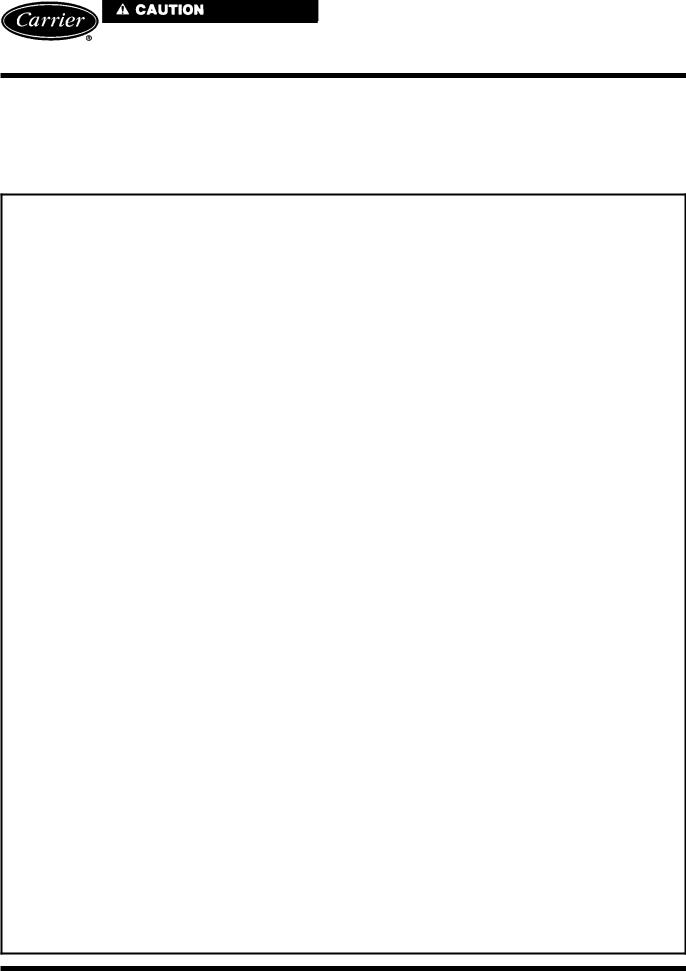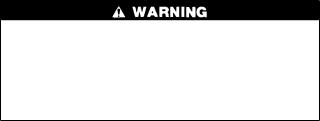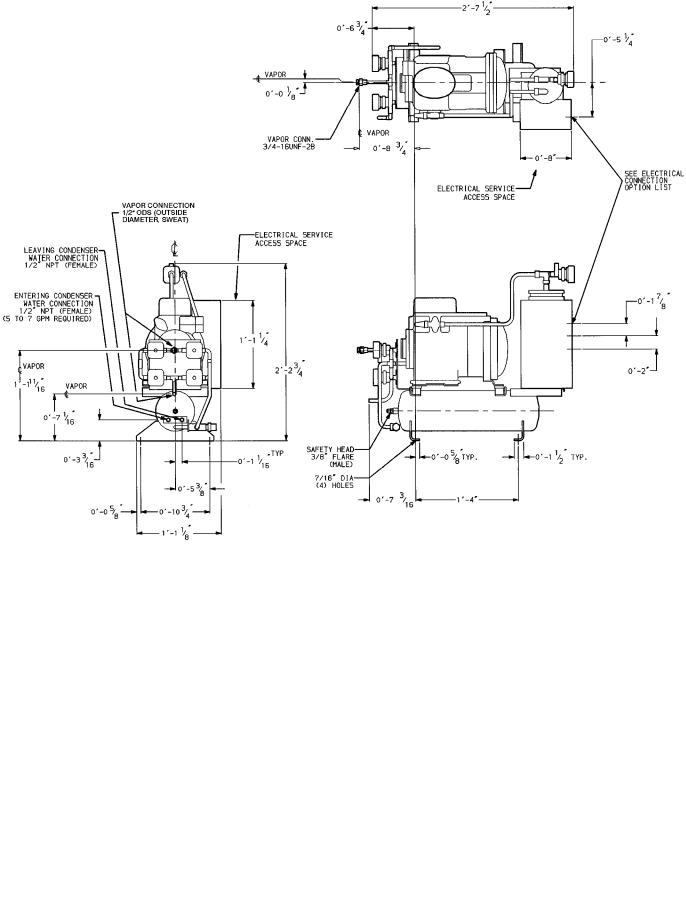Carrier 19XB User Manual

19XB Positive Pressure Storage System 50/60 Hz
Installation, Operating, and Maintenance
Instructions
For Use With Positive Pressure Chillers
SAFETY CONSIDERATIONS
Positive pressure storage systems are designed to provide safe and reliable service when operated within design speci®cations. When operating this equipment, use good judgment and safety precautions to avoid damage to equipment and property or injury to personnel.
Be sure you understand and follow the procedures and safety precautions contained in this guide.
DO NOT VENT refrigerant relief valves within a building. Outlet from rupture disc or relief valve must be vented outdoors in accordance with the latest edition of ASHRAE 15 (American Society of Heating, Refrigeration, and Air Conditioning Engineers). The accumulation of refrigerant in an enclosed space can displace oxygen and cause asphyxiation.
PROVIDE adequate ventilation in accordance with ASHRAE 15, especially for enclosed and low overhead spaces. Inhalation of high concentrations of vapor is harmful and may cause heart irregularities, unconsciousness, or death. Misuse can be fatal. Vapor is heavier than air and reduces the amount of oxygen available for breathing. Product causes eye and skin irritation. Decomposition products are hazardous.
DO NOT USE OXYGEN to purge lines or to pressurize a machine for any purpose. Oxygen gas reacts violently with oil, grease, and other common substances.
NEVER EXCEED speci®ed test pressures, VERIFY the allowable test pressure by checking the instruction literature and the design pressures on the equipment nameplate.
DO NOT USE air for leak testing. Use only tracer gases and dry nitrogen.
DO NOT VALVE OFF any safety device.
BE SURE that all pressure relief devices are properly installed and functioning before operating any machine.
DO NOT WELD OR FLAMECUT any refrigerant line or vessel until all refrigerant (liquid and vapor) has been removed from chiller. Traces of vapor should be displaced with dry air or nitrogen and the work area should be well ventilated. Refrigerant in contact with an open ¯ame produces toxic gases.
DO NOT USE eyebolts or eyebolt holes to rig machine sections or the entire assembly.
DO NOT work on high-voltage equipment unless you are a quali- ®ed electrician.
DO NOT WORK ON electrical components, including control panels, switches, starters, or oil heater until you are sure ALL POWER IS OFF and no residual voltage can leak from capacitors or solidstate components.
LOCK OPEN AND TAG electrical circuits during servicing. IF WORK IS INTERRUPTED, con®rm that all circuits are deenergized before resuming work.
DO NOT syphon refrigerant by mouth.
AVOID SPILLING liquid refrigerant on skin or getting it into the eyes. USE SAFETY GOGGLES. Wash any spills from the skin
with soap and water. If any enters the eyes, IMMEDIATELY FLUSH EYES with water and consult a physician.
NEVER APPLY an open ¯ame or live steam to a refrigerant cylinder. Dangerous overpressure can result. When necessary to heat refrigerant, use only warm (110 F [43 C]) water.
DO NOT REUSE disposable (nonreturnable) cylinders or attempt to re®ll them. It is DANGEROUS AND ILLEGAL. When cylinder is emptied, evacuate remaining gas pressure, loosen the collar and unscrew and discard the valve stem. DO NOT INCINERATE.
CHECK THE REFRIGERANT TYPE before transferring refrigerant to the machine. The introduction of the wrong refrigerant can cause damage or malfunction to this machine.
Operation of this equipment with refrigerants other than those cited herein should comply with ASHRAE 15 (latest edition). Contact Carrier for further information on use of this machine with other refrigerants.
DO NOT ATTEMPT TO REMOVE ®ttings, covers, etc., while machine is under pressure or while machine is running. Be sure pressure is at 0 psig (0 kPa) before breaking any refrigerant connection.
CAREFULLY INSPECT all relief devices, rupture discs, and other relief devices AT LEAST ONCE A YEAR. If machine operates in a corrosive atmosphere, inspect the devices at more frequent intervals.
DO NOT ATTEMPT TO REPAIR OR RECONDITION any relief device when corrosion or build-up of foreign material (rust, dirt, scale, etc.) is found within the valve body or mechanism. Replace the device.
DO NOT install relief devices in series or backwards.
USE CARE when working near or in line with a compressed spring. Sudden release of the spring can cause it and objects in its path to act as projectiles.
DO NOT STEP on refrigerant lines. Broken lines can whip about and cause personal injury and damage to the machine.
DO NOT climb over a machine. Use platform, catwalk, or staging. Follow safe practices when using ladders.
USE MECHANICAL EQUIPMENT (crane, hoist, etc.) to lift or move inspection covers or other heavy components. Even if components are light, use such equipment when there is a risk of slipping or losing your balance.
BE AWARE that certain automatic start arrangements CAN ENGAGE THE STARTER. Open the disconnect ahead of the starter in addition to shutting off the machine or pump.
USE only repair or replacement parts that meet the code requirements of the original equipment.
DOUBLE-CHECK that coupling nut wrenches, dial indicators, or other items have been removed before rotating any shafts.
DO NOT LOOSEN a packing gland nut before checking that the nut has a positive thread engagement.
PERIODICALLY INSPECT all valves, ®ttings, and piping for corrosion, rust, leaks, or damage.
DO NOT MIX REFRIGERANT from chillers that use different compressor oils. Compressor damage can result.
Manufacturer reserves the right to discontinue, or change at any time, speci®cations or designs without notice and without incurring obligations.
Book |
2 |
|
PC 211 |
Catalog No. 531-927 |
Printed in U.S.A. |
Form 19XB-1SI |
Pg 1 |
6-96 |
Replaces: New |
Tab |
5a |
|
|
|
|
|
|
|
|
|
|
|
|
|
|
|
|
|
|
CONTENTS
Page
SAFETY CONSIDERATIONS . . . . . . . . . . . . . . . . . . . 1
INTRODUCTION . . . . . . . . . . . . . . . . . . . . . . . . . . . . . . 2
INSTALLATION . . . . . . . . . . . . . . . . . . . . . . . . . . . . . 2-10
Complete Pre-Installation Checks . . . . . . . . . . . . . 2
·IDENTIFY UNIT
·INSPECT SHIPMENT
Mount the Pumpout Unit . . . . . . . . . . . . . . . . . . . . . 3
·MOUNTING ON THE CHILLER
·FLOOR MOUNTING
Rig the Storage Tank . . . . . . . . . . . . . . . . . . . . . . . . . 3
Make Piping Connections . . . . . . . . . . . . . . . . . . . . 7
· INSTALL VENT PIPING TO RELIEF DEVICES
Make Electrical Connections . . . . . . . . . . . . . . . . . . 7
CONTROLS AND COMPONENTS . . . . . . . . . . . . . . 11
Pumpout Unit . . . . . . . . . . . . . . . . . . . . . . . . . . . . . . . . 11
·CONTROLS
·SAFETY CONTROL SETTINGS
·COMPRESSOR
·CONDENSER
·OIL SEPARATOR
·SUCTION AND DISCHARGE VALVES
Storage Tank . . . . . . . . . . . . . . . . . . . . . . . . . . . . . . . . 11
·DRAIN VALVE
·DUAL RELIEF VALVES
·PRESSURE GAGE
·LEVEL GAGE
OPERATION . . . . . . . . . . . . . . . . . . . . . . . . . . . . . . . 11-15
Overview . . . . . . . . . . . . . . . . . . . . . . . . . . . . . . . . . . . 11
·REFRIGERANT TRANSFER
·TRANSFERRING LIQUID REFRIGERANT FROM THE CHILLER COOLER TO THE CHILLER CONDENSER OR PUMPOUT STORAGE TANK
·TRANSFERRING LIQUID REFRIGERANT FROM THE CHILLER CONDENSER OR PUMPOUT STORAGE TANK TO THE CHILLER COOLER
·DISTILLING THE REFRIGERANT
Pumpout and Refrigerant Transfer
Procedures . . . . . . . . . . . . . . . . . . . . . . . . . . . . . . . 12
·OPERATING THE PUMPOUT UNIT
·TO READ REFRIGERANT PRESSURES
·POSITIVE PRESSURE CHILLERS WITH STORAGE TANKS
·CHILLERS WITH ISOLATION VALVES
·DISTILLING THE REFRIGERANT
MAINTENANCE . . . . . . . . . . . . . . . . . . . . . . . . . . . . 15,16
Pumpout Unit . . . . . . . . . . . . . . . . . . . . . . . . . . . . . . . 15
· PUMPOUT COMPRESSOR OIL CHARGE
Storage Tank . . . . . . . . . . . . . . . . . . . . . . . . . . . . . . . 16
Ordering Replacement Parts . . . . . . . . . . . . . . . . . 16
TROUBLESHOOTING . . . . . . . . . . . . . . . . . . . . . . . . 16
INTRODUCTION
The 19XB Positive Pressure Storage (PPS) System has been designed to help owners and operators of positive pressure chillers store refrigerants HCFC-22 and HFC-134a during service and repair work. The 19XB system conserves these refrigerants and prevents the release of excessive amounts of refrigerant into the atmosphere. The proper use of this equipment minimizes the loss of HFCs and HCFCs.
The 19XB PPS system shown in Fig. 1 consists of a pumpout unit mounted on a storage tank. The pumpout unit is offered as a free-standing unit that can be used with chillers that have an existing storage tank or with chillers that have isolation valves that permit built-in refrigerant storage.
The 19XB PPS systems are factory tested and certi®ed to the American Society of Mechanical Engineers (ASME) pressure vessel code. The tanks are constructed of certi®ed steel and are pressure rated at 300 psig (2068 kPa). The PPS storage tank is equipped with dual relief valves for proper venting per ASHRAE 15 (American Society of Heating Refrigeration, and Air Conditioning Engineers) guidelines. An automatic level switch is prewired to the control circuit to ensure proper storage levels.
The 19EA pumpout unit is a complete, hermetic, compact unit that consists of:
·a spring-mounted reciprocating compressor with a directdrive motor
·a water-cooled refrigerant condenser
·an oil separator
·suction and discharge valves to control refrigerant ¯ow
·prewired safety and control devices.
When referencing refrigerant charges in this manual, the HCFC-22 charge will be listed ®rst and the HFC-134a value will follow in brackets.
INSTALLATION
Complete Pre-Installation Checks
IDENTIFY UNIT Ð Identify the assembly number (Table 1) printed on the pumpout unit and storage tank nameplates. Check this information against the job requirements. Fig. 1 shows the PPS system and its major components. Refer to Tables 2 and 3 for physical data.
INSPECT SHIPMENT Ð Inspect unit for damage before removing unit from shipping conveyance. If unit appears damaged, it should be inspected by a shipping inspector before removal. File a claim with the shipping company if shipment is damaged or incomplete. The manufacturer is not responsible for damage incurred during transit.
Check all components. Notify the supplier immediately if any item is missing. To prevent loss or damage, leave all parts in their original package until they are needed.
2

Table 1 Ð Positive Pressure System Assembly Numbers
POSITIVE PRESSURE |
PUMPOUT UNIT |
|
COMPRESSOR MOTOR |
MAXIMUM |
|
STORAGE |
|
SYSTEM ASSEMBLY |
REFRIGERANT |
LRA |
|||||
ASSEMBLY NO. |
(V-Ph-Hz) |
RLA |
TANK |
||||
NUMBER |
|
|
|||||
|
|
|
|
|
|
||
19XB04280205 |
19EA42-748 |
R-22 |
208-3-60 |
13.2 |
63.5 |
28 cu ft |
|
19XB04280206 |
19EA44-748 |
R-22 |
230-3-60 |
11.5 |
57.5 |
28 cu ft |
|
19XB04280207 |
19EA46-748 |
R-22 |
400/460-3-50/60 |
5.8 |
28.8 |
28 cu ft |
|
19XB04280208 |
19EA47-748 |
R-22 |
575-3-60 |
4.6 |
23.0 |
28 cu ft |
|
19XB04280213 |
19EA48-748 |
R-134a |
208-3-60 |
13.2 |
63.5 |
28 cu ft |
|
19XB04280214 |
19EA49-748 |
R-134a |
230-3-60 |
11.5 |
57.5 |
28 cu ft |
|
19XB04280215 |
19EA51-748 |
R-134a |
400/460-3-50/60 |
5.8 |
28.8 |
28 cu ft |
|
19XB04280216 |
19EA52-748 |
R-134a |
575-3-60 |
4.6 |
23.0 |
28 cu ft |
|
19XB04280601 |
19EA42-748 |
R-22 |
208-3-60 |
13.2 |
63.5 |
None |
|
19XB04280602 |
19EA44-748 |
R-22 |
230-3-60 |
11.5 |
57.5 |
None |
|
19XB04280603 |
19EA46-748 |
R-22 |
400/460-3-50/60 |
5.8 |
28.8 |
None |
|
19XB04280604 |
19EA47-748 |
R-22 |
575-3-60 |
4.6 |
23.0 |
None |
|
19XB04280605 |
19EA48-658 |
R-134a |
208-3-60 |
13.2 |
63.5 |
None |
|
19XB04280606 |
19EA49-658 |
R-134a |
230-3-60 |
11.5 |
57.5 |
None |
|
19XB04280607 |
19EA51-658 |
R-134a |
400/460-3-50/60 |
5.8 |
28.8 |
None |
|
19XB04280608 |
19EA52-658 |
R-134a |
575-3-60 |
4.6 |
23.0 |
None |
|
19XB04520205 |
19EA42-748 |
R-22 |
208-3-60 |
13.2 |
63.5 |
52 cu ft |
|
19XB04520206 |
19EA44-748 |
R-22 |
230-3-60 |
11.5 |
57.5 |
52 cu ft |
|
19XB04520207 |
19EA46-748 |
R-22 |
400/460-3-50/60 |
5.8 |
28.8 |
52 cu ft |
|
19XB04520208 |
19EA47-748 |
R-22 |
575-3-60 |
4.6 |
23.0 |
52 cu ft |
|
19XB04520213 |
19EA48-748 |
R-134a |
208-3-60 |
13.2 |
63.5 |
52 cu ft |
|
19XB04520214 |
19EA49-748 |
R-134a |
230-3-60 |
11.5 |
57.5 |
52 cu ft |
|
19XB04520215 |
19EA51-748 |
R-134a |
400/460-3-50/60 |
5.8 |
28.8 |
52 cu ft |
|
19XB04520216 |
19EA52-748 |
R-134a |
575-3-60 |
4.6 |
23.0 |
52 cu ft |
|
|
|
|
|
|
|
|
LEGEND
LRA Ð Locked Rotor Amps
RLA Ð Rated Load Amps
NOTES:
1.All storage vessels are 300 psig (2068 kPa) designs per the ASME (American Society of Mechanical Engineers) Boiler Pressure Vessel Code, Section VIII Division 1.
2.All units above are shipped with a 15 psig (103 kPa) nitrogen charge.
3.Nominal horsepower for all pumpout units is 3.0.
Mount the Pumpout Unit Ð The pumpout unit, if purchased separately, may be mounted directly on the chiller or it may be ¯oor mounted.
MOUNTING ON THE CHILLER Ð See instructions provided with the chiller for mounting the pumpout unit. A typical chiller mount is shown in Fig. 2.
FLOOR MOUNTING Ð Select a ventilated and accessible area, free of traffic or other hazards. Remove and discard the 4 angle supports at the base of the pumpout unit and bolt the unit to the ¯oor through the 47¤16 in. holes at the base of the pumpout unit. Special isolation is unnecessary. Contact surface and dimensions for the pumpout unit are given in Fig. 3.
Rig the Storage Tank Ð The complete 19XB system can be rigged as a single assembly. See the rigging instructions on the label attached to the assembly. Also refer to the rigging guide (Fig. 4), physical data in Tables 2 and 3, and contact surface and dimensions for the complete system in Fig. 5. Lift the assembly only from the 4 points indicated in the rigging guide. Each rigging cable must be capable of supporting the entire weight of the assembly.
Lifting the assembly from points other than those speci- ®ed may result in serious damage to the assembly and personal injury. Rigging equipment and procedures must be adequate for assembly. See Tables 2 and 3 for weights. NOTE: These weights are broken down into pumpout unit and storage tank weights. For the complete assembly weight, add all components together.
3

VENT VALVE
VALVES
VALVES |
CONTROL BOX |
|
(WIRING BY |
||
|
CONTRACTOR) |
|
|
COMPRESSOR |
|
CONDENSER |
REFRIGERANT |
|
WATER |
||
INLET VALVE |
||
CONNECTIONS |
||
|
||
(FIELD PIPING) |
|
19EA PUMPOUT UNIT
19EA CONTROL BOX (INTERIOR)
19EA PUMPOUT UNITS
Fig. 1 Ð 19XB Positive Pressure Storage System
4

*3¤8-16 bolts × 1-in. lg; 4 required.
Fig. 2 Ð 19EA Pumpout Unit: Typical Chiller Mount
ELECTRICAL CONNECTION
OPTION LIST
TRADE SIZE |
QTY |
LOCATION |
1¤2( |
1 |
TOP |
3¤4( |
1 |
BOTTOM |
1( |
1 |
MIDDLE |
11¤4( |
1 |
MIDDLE |
Fig. 3 Ð Pumpout Unit Contact Surfaces and Dimensions
5
